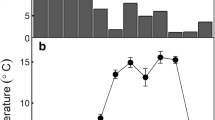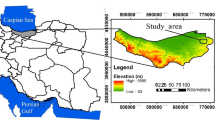Abstract
Monitoring soil CO2 respiration with chamber measurements and identifying controlling factors such as the diversity of vegetation species, moisture and temperature can help guide desert scrubland management. Soil CO2 respiration and potential controlling factors at four sites in desert scrubland were examined along the Sangong River Basin (SRB) in northwestern China in 2004. Soil CO2 respiration descended along the SRB as did the diversity of vegetation species, air temperature and air humidity. The two sites of the field station (FS) and the north desert (ND) and the low reaches of the SRB among these locations were monitored to analyze the effects of pH value, soil organic carbon (SOC), total nitrogen (TN) and calcium carbonate (CaCO3) on soil CO2 respiration during the growing season in 2005. The ND site was located at the southern edge of the Gurbantunggut Desert; the FS site was in the border area of the SRB Alluvial Fan. One-way ANOVA was performed. The result showed that air humidity and CaCO3 content had a strong influence on soil CO2 respiration; SOC content was a limitation to soil CO2 respiration in the arid-desert zone. Effective management activities can attenuate soil CO2 respiration and keep carbon balance trends at a desirabe level in desert scrublands.




Similar content being viewed by others
References
Collins HP, Cavigelli MA (2003) Soil microbial community characteristics along an elevation gradient in the laguna Mountains of Southern California. Soil Biol Biochem 35:1027–1037
Conant RT, Peter DB, Klopatek CC, Klopatek JM (2004) Controls on soil respiration in semiarid soils. Soil Biol Biochem 36:945–951
Dilustro JJ, Collins B, Duncan L, Crawford C (2005) Moisture and soil texture effects on soil CO2 efflux components in southeastern mixed pine forests. For Ecol Manag 204:85–95
Duan JN, Li BG, Shi YC, Yan TL, Zhu DH (1999) Modeling of soil CaCO3 deposition process in arid areas. Acta Pedologica Sinica 36(3):318–326
Duponnois R, Paugy M, Thioulouse J, Masse D, Lepage M (2005) Functional diversity of soil microbial community, rock phosphate dissolution and growth of Acacia Seyal as influenced by grass-, litter- and soil-feeding termite nest structure amendments. Geoderma 124:349–361
Editorial Committee (1996) Soil physical and chemical analysis and description of soil profiles. Standards Press of China, Beijing (In Chinese)
Flanagan LB, Johnson BG (2005) Interacting effects of temperature, soil moisture and plant biomass production on ecosystem respiration in a northern temperate grassland. Agric For Meteorol 130: 237–253
Fuentes JP, Bezdicek DF, Flury M, Albrecht S, Smith JL (2006) Microbial activity affected by lime in a long-term no-till soil. Soil Tillage Res 88:123–131
Gallardo A, Schlesinger WH (1992) Carbon and nitrogen of soil microbial biomass in desert ecosystems. Biogeochemistry 18:1–17
Lloyd J, Taylor JA (1994) On the temperature dependence of soil respiration. Funct Ecol 8:315–323
Luo GP, Chen X, Zhou KF, Ye MQ (2002) Study on stability and spatio-temporal variance for oasis in Sangong River basin. Science in China (Ser D)
Maestre FT, Cortina J (2003) Small-scale spatial variation in soil efflux in a Mediterranean semiarid steppe. Appl Soil Ecol 23:199–209
Mielnick PC, Dugas WA (2000) Soil CO2 flux in a tallgrass prairie. Soil Biol Biochem 32:221–228
Nanjing Agriculture University (1966) Chemical analysis methods in soil and agriculture. China Agricultural Press, Beijing
Nanjing Institute of Soil Science, Chinese Academy of Sciences (1978) Soil analysis in characteristic of chemistry and physics. Shanghai technology and Science Press, Shanghai
Pan GX (1999) Pedogenic carbonates in aridic soils of China and the significance in terrestrial carbon transfer. J Nanjing Agric Univ 22(I):51–57
Raich JW, Schlesinger WH (1992) The global carbon dioxide flux in soil respiration and its relationship to vegetation and climate. Tellus 44B:81–99
Raich JW, Potter CS (1995) Global patterns of carbon dioxide emissions from soils. Global Biogeochem Cycles 9:23–36
Reynolds JF (2001) Desertification In: Levin S.A. (ed) Encyclopedia of biodiversity, vol 2. Academic, San Diego pp. 61–78
Rietz DN, Hayes RJ (2003) Effects of irrigation-induced salinity and sodicity on soil microbial activity. Soil Biol Biochem 35:845–854
Ritz K, McNicol JW, Nunan N, Grayston S, Millard P, Atkinson D, Gollotte A, Habeshaw D et al. (2004) Spatial structure in soil chemical and microbiological properties in an upland grassland FEMS Microbiol Ecol 49:191–205
Rutigliano FA, Ascoli RD, Santo AVD (2004) Soil microbial metabolism and nutrient status in a Mediterranean area as affected by plant cover. Soil Biol Biochem 36: 1719–1729
Schlesinger WH, Pilmanis AM (1998) Plant–soil interactions in desert. Biogeochemistry 42: 169–187
Schlesinger WH, Andrews JA (2000) Soil respiration and the global carbon cycle. Biogeochemistry 48:7–20
Shannon C (1948) A mathematical theory of communication. Bell Syst Tech J 27:379–423
Singh JS, Gupta SR (1977) Plant decomposition and soil respiration in terrestrial ecosystems. Bot Rev 43:449–528
Zhang LJ, Yue M, Zhao GF, Zhang YD, Gu FX, Pan XL (2002) Plant community species diversity on oasis-desert ecotone in Fukang of Xinjiang and comparison of its measurement. Acta Bot Boreal-Occident Sin 22:350–358
Zhang YM, Chen J, Wang XQ, Pan HX, Gu ZH, Pan BR (2005) The distribution patterns of biological soil crust in Gurbantunggut Desert. Acta Geographica sinica 60:53–60
Zhou JN (2001) The compiling of Fukang. Xinjiang People’s Publishing House 85–110
Acknowledgments
This study was funded by the National 863 project (2006AA10Z226), the Innovation Project of CAS (KZCX2-YW-127) and the National Natural Science Foundation (40571011) of China. The authors would like to thank to Mrs. Yue H. X. for the laboratory assistance.
Author information
Authors and Affiliations
Corresponding author
Rights and permissions
About this article
Cite this article
Zhu, H., Zhao, C., Li, J. et al. Analysis of impact factors on scrubland soil respiration in the southern Gurbantunggut Desert, central Asia. Environ Geol 54, 1403–1409 (2008). https://doi.org/10.1007/s00254-007-0921-5
Received:
Accepted:
Published:
Issue Date:
DOI: https://doi.org/10.1007/s00254-007-0921-5




